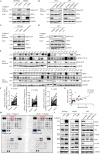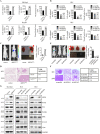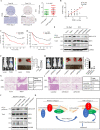DDR1 promotes hepatocellular carcinoma metastasis through recruiting PSD4 to ARF6
- PMID: 35140331
- PMCID: PMC8933278
- DOI: 10.1038/s41388-022-02212-1
DDR1 promotes hepatocellular carcinoma metastasis through recruiting PSD4 to ARF6
Abstract
Discoidin domain receptor 1 (DDR1) is a member of the receptor tyrosine kinase family, and its ligand is collagen. Previous studies demonstrated that DDR1 is highly expressed in many tumors. However, its role in hepatocellular carcinoma (HCC) remains obscure. In this study, we found that DDR1 was upregulated in HCC tissues, and the expression of DDR1 in TNM stage II-IV was higher than that in TNM stage I in HCC tissues, and high DDR1 expression was associated with poor prognosis. Gene expression analysis showed that DDR1 target genes were functionally involved in HCC metastasis. DDR1 positively regulated the migration and invasion of HCC cells and promoted lung metastasis. Human Phospho-Kinase Array showed that DDR1 activated ERK/MAPK signaling pathway. Mechanically, DDR1 interacted with ARF6 and activated ARF6 through recruiting PSD4. The kinase activity of DDR1 was required for ARF6 activation and its role in metastasis. High expression of PSD4 was associated with poor prognosis in HCC. In summary, our findings indicate that DDR1 promotes HCC metastasis through collagen induced DDR1 signaling mediated PSD4/ARF6 signaling, suggesting that DDR1 and ARF6 may serve as novel prognostic biomarkers and therapeutic targets for metastatic HCC.
© 2022. The Author(s).
Conflict of interest statement
The authors declare no competing interests.
Figures







References
-
- Villanueva A. Hepatocellular Carcinoma. N Engl J Med. 2019;380:1450–62. - PubMed
-
- Tsochatzis EA, Meyer T, Burroughs AK. Hepatocellular carcinoma. N Engl J Med 366. 2012;92:92–3. - PubMed
-
- Agarwal G, Mihai C, Iscru DF. Interaction of discoidin domain receptor 1 with collagen type 1. J Mol Biol. 2007;367:443–55. - PubMed
-
- Weiner HL, Huang H, Zagzag D, Boyce H, Lichtenbaum R, Ziff EB. Consistent and selective expression of the discoidin domain receptor-1 tyrosine kinase in human brain tumors. Neurosurgery. 2000;47:1400–9. - PubMed
MeSH terms
Substances
LinkOut - more resources
Full Text Sources
Medical
Molecular Biology Databases
Research Materials
Miscellaneous

